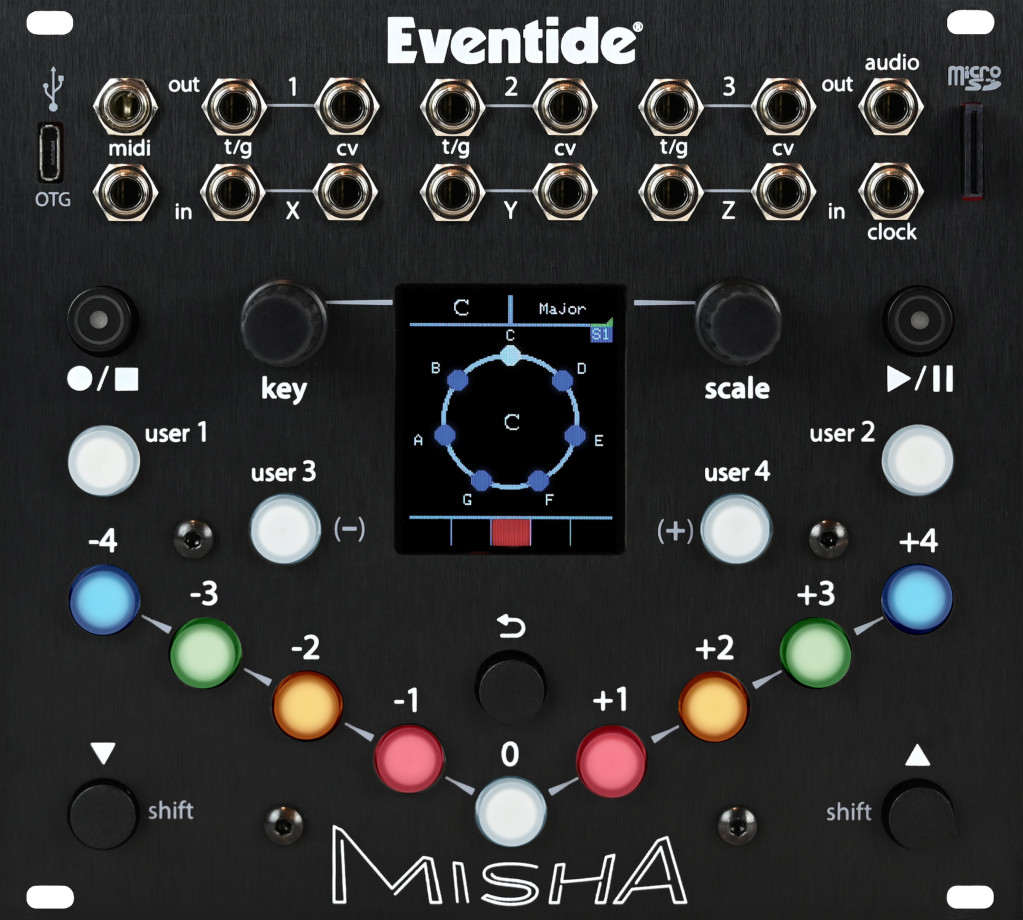I’m super serial! Eventide has a new sequencer for creating modular melodies and intervals – and it started with twelve-tone rows as its inspiration. With audio, CV, and waveform out, it could be a merry melodic source for a modular setup.
There’s a ton in here. It could be an answer to the idea that modular can’t be melodic or… tuned, even. It looks really elegant and approachable and complete. (Though this is still a somewhat western approach to melody and tuning — more on that in a bit.)
The basic idea:
Start with a root key and set a scale (via a bunch or pre-loaded scales or custom user scales – with full Scala support including non-octave-repeating tables).
Program and play melodies based on intervals.
Apply prime, retrograde, inversion, and other operations to the melody for variations.
Clock your melody / divide for different rhythms.
Output melody as MIDI, control voltage, or audio waveforms. (That last one is handy, as it means you can get something coming out of this even without having to connect a separate oscillator.)
And it’s polyphonic, plus there’s both USB connectivity and MicroSD onboard for storage.

Full specs:
Innovative 28hp Eurorack instrument/sequencer that utilizes a unique, interval-based
approach to playing and creating melodiesMake sound three ways via MIDI, control voltage (with three independent gate/cv pairs)
or outputting waveforms via the audio jackExternal control templates for MIDI and QWERTY keyboards
100 factory scales and additional slots for up to 100 user/custom scales (Scala support)
Tone row-based sequencer inspired by the classic compositional technique used in serial
musicComprehensive control of sequence playback to easily manipulate and expand upon
your musical ideasCreate rhythmic variations using clock division
18 user presets
CV inputs for external trigger/control sources
Clock input for syncing to external sources. User configurable PPQ settings
Audio output for internal oscillator
Polyphony via 3 CV outputs or MIDI
Micro-USB for easy firmware updates using Eventide Device Manager
Micro-SD card for saving/loading scales and settings
https://www.eventideaudio.com/rackmount/misha/
US$599.
Wait, back up a second – QWERTY keyboard control as well as MIDI?
That could be because Leon “samchillian” Gruenbaum was on this project, creator of the instrument of the same name, which used relative operations to generate melodies. An early version of his circuit-bent QWERTY keyboard was one of the first stories ever on CDM.
QWERTY input will be a must, clearly.
There’s also a lovely graphical display. And these mathematical operations to me are maybe the most interesting part. Sure, you can think of them as being derived from Arnold Schoenberg or the Second Viennese School. (I mean, I know that always gets the party going!) But you don’t have to conceive them that way: these are essentially matrix operations from mathematics. I think you could even make the argument that those kinds of operations are likely emergent in our brains and even how we hear.
The interface for Misha, though, is pretty well grounded in western concert music. To my surprise, there isn’t a master tuning setting, so you can’t even tune to a different master frequency for the outputs. It’s a bit odd to me to offer options like just intonation but stick the musician with A=440Hz, which is not a universal standard even in concert music – let alone with a bunch of analog gear. (Even most entry-level digital pianos offer master tuning.) Bastl’s 1983, for instance, tunes to 440Hz by default but gives you other options.
Free tuning becomes even more important in use with Scala tunings – and making use of those 100 custom banks. I think it’s important to say this is not a need of the “microtonal community,” which suggests microtonal is the niche, and concert music is the standard. It’s rather best expressed as being able to use modular as a free canvas that can accommodate musical traditions other than just 20th century “common practice” western European concert music and relatives.
So I get that there is the use of the key signatures for western music; it’d just be great to have a ‘free’ mode without them. (It’s a little like having a choice between free and tempo-synced in LFOs, but with pitch.)
Now, that being said – I think with a little extra work and oscillator tuning, you could hack around this, and the sequencing features will still be interesting enough even for those non-12-TET / non-440Hz scenarios. It’s actually not that hard to do in the analog domain, since it’s not uncommon to tune modules separately anyway. So this is still a great way of spitting out intervals or interval-related control signal. Also – updated/clarification: Non-octave-repeating scales is exciting. That means that gamut could be whatever tuning/temperament you want.
You don’t even really have to use this entirely as tuned pitch-domain stuff – it could very well help make patterns for other parameters, like CV routed to effects! And then all those mathematical operations become nice ways of structuring pattern and variation.
I’m really eager to check this one out. It’s one of the nicer-looking melodic sequencers we’ve seen yet.
More videos – full playlist.
What sequencer has your eye in modular? Let us know in comments.